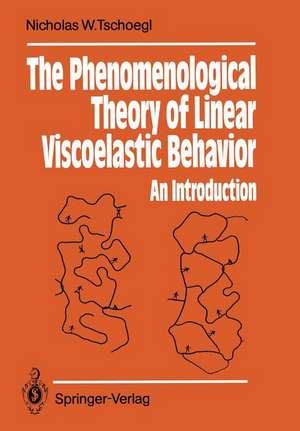The Phenomenological Theory of Linear Viscoelastic Behavior: An Introduction
Autor Nicholas W. Tschoegl Ilustrat de Christopher A. Tschoeglen Limba Engleză Paperback – 10 dec 2011
Preț: 670.30 lei
Preț vechi: 788.59 lei
-15% Nou
Puncte Express: 1005
Preț estimativ în valută:
128.26€ • 134.27$ • 106.13£
128.26€ • 134.27$ • 106.13£
Carte tipărită la comandă
Livrare economică 05-19 aprilie
Preluare comenzi: 021 569.72.76
Specificații
ISBN-13: 9783642736049
ISBN-10: 3642736041
Pagini: 800
Ilustrații: XXV, 769 p.
Dimensiuni: 170 x 244 x 42 mm
Greutate: 1.25 kg
Ediția:Softcover reprint of the original 1st ed. 1989
Editura: Springer Berlin, Heidelberg
Colecția Springer
Locul publicării:Berlin, Heidelberg, Germany
ISBN-10: 3642736041
Pagini: 800
Ilustrații: XXV, 769 p.
Dimensiuni: 170 x 244 x 42 mm
Greutate: 1.25 kg
Ediția:Softcover reprint of the original 1st ed. 1989
Editura: Springer Berlin, Heidelberg
Colecția Springer
Locul publicării:Berlin, Heidelberg, Germany
Public țintă
GraduateCuprins
1. Introductory Concepts.- 1.0 Introduction.- 1.1 Constitutive Equations.- 1.2 Stress.- 1.3 Strain and Rate of Strain.- 1.4 Purely Elastic Linear Response.- 1.5 Purely Viscous Linear Response.- 1.6 Problems.- References.- 2. Linear Viscoelastic Response.- 2.0 Introduction.- 2.1 Linear Time-dependent Behavior.- 2.2 The Impulse Response Functions.- 2.3 The Step Response Functions.- 2.4 The Slope Response Functions.- 2.5 The Harmonic Response Functions.- 2.6 Excitation and Response in the Time Domain.- 2.7 Problems.- References.- 3. Representation of Linear Viscoelastic Behavior by Series-Parallel Models.- 3.0 Introduction.- 3.1 The Theory of Model Representation.- 3.2 Electromechanical Analogies.- 3.3 The Elementary Rheological Models.- 3.4 Models with the Minimum Number of Elements.- 3.5 Models with Large Numbers of Elements.- 3.6 Model Fitting.- 3.7 Series-Parallel Models and the Operator Equation.- 3.8 Problems.- References.- 4. Representation of Linear Viscoelastic Behavior by Spectral Response Functions.- 4.0 Introduction.- 4.1 The Continuous Spectral Response Functions.- 4.2 Methods for Deriving the Continuous Spectra from the Step Responses.- 4.3 Methods for Deriving the Continuous Spectra from the Harmonic Responses.- 4.4 Comparison of the Approximation to the Continuous Spectra.- 4.5 The Discrete Spectral Response Functions.- 4.6 The Viscoelastic Constants.- 4.7 Problems.- References.- 5. Representation of Linear Viscoelastic Behavior by Ladder Models.- 5.0 Introduction.- 5.1 General Ladder Models.- 5.2 Regular Ladder Models with a Finite Number of Elements: The Gross-Marvin Models.- 5.3 Regular Ladder Models with a Finite Number of Elements: The Regular Converse Ladder Models.- 5.4 Comparison of the Obverse and Converse Regular Ladder Models. Model Fitting.- 5.5Regular Ladder Models with an Infinite Number of Elements.- 5.6 The Continuous Ladder or Material Transmission Line.- 5.7 Problems.- References.- 6. Representation of Linear Viscoelastic Behavior by Mathematical Models.- 6.0 Introduction.- 6.1 Modelling by the Use of Matching Functions.- 6.2 Models Based on Fractional Differentiation (Power Laws).- 6.3 Modelling of the Spectral Response Functions.- 6.4 Problems.- References.- 7. Response to Non-Standard Excitations.- 7.0 Introduction.- 7.1 Response to the Removal or the Reversal of a Stimulus.- 7.2 Response to Repeated Non-Cyclic Excitations.- 7.3 Response to Cyclic Excitations.- 7.4 Approximations to the Spectra from Responses to Non-Standard Excitations.- 7.5 Problems.- References.- 8. Interconversion of the Linear Viscoelastic Functions.- 8.0 Introduction.- 8.1 Interconversion Between Relaxation and Creep Response Functions..- 8.2 Interconversion Between Time- and Frequency-Dependent Response Functions.- 8.3 Interconversion Within the Frequency Domain.- 8.4 Problems.- References.- 9. Energy Storage and Dissipation in a Linear Viscoelastic Material.- 9.0 Introduction.- 9.1 Strain Excitation (Stress Relaxation Behavior).- 9.2 Stress Excitation (Creep Behavior).- 9.3 Hysteresis.- 9.4 Problems.- 9.5 References.- 10. The Modelling of Multimodal Distributions of Respondance Times.- 10.0 Introduction.- 10.1 Bimodal Distributions.- 10.2 Prolongated Unimodal Distributions.- 10.3 Problems.- References.- 11. Linear Viscoelastic Behavior in Different Modes of Deformation.- 11.0 Introduction.- 11.1 The General (Anisotropic) Viscoelastic Stress-Strain Relations.- 11.2 The Isotropic Viscoelastic Stress-Strain Relations.- 11.3 Linear Viscoelastic Behavior of Isotropic Materials in Different Modes of Deformation.- 11.4 Interconversion of the Isotropic Response Functions in Different Modes of Deformation.- 11.5 Problems.- References.- Appendix: Transformation Calculus.- A1 Introduction.- A 2 Special Functions.- A2.1 The Delta Function.- A2.2 The Step Function.- A2.3 The Gate Function.- A2.4 The Slope Function.- A 2.5 The Ramp Function.- A3 The Laplace Transform.- A3.1 Properties.- A 3.1.1 Linearity.- A3.1.2 Uniqueness.- A3.1.3 Translation.- A3.1.4 Real Differentiation.- A3.1.5 Real Integration.- A3.1.6 Real Convolution.- A3.1.7 Limit Values.- A3.1.8 Cut-off. The Finite Laplace Transform.- A3.1.9 Repetition.- A3.2 Inversion.- A3.2.1 The Residue Theorem.- A3.2.2 Inversion on the Real Axis.- A3.3 Laplace Transform Pairs.- A 3.4 The s-Multiplied Laplace Transform (Carson Transform).- A4 The Fourier Transform.- A 4.1 Properties.- A4.2 Inversion.- A 4.3 Generalized Fourier Transforms.- A 4.4 Generalized Fourier Transform Pairs.- A 5 The Stieltjes Transform.- A5.1 Properties.- A 5.2 Inversion.- A 5.2.1 The Jump.- A 5.2.2 Inversion on the Real Axis.- A5.3 The Fourier-Laplace Transform.- A 5.4 Stieltjes Transform Pairs.- A 6 The Hilbert Transform.- A 6.1 Inversion.- References.- Solutions to Problems.- 1.- 2.- 3.- 4.- 5.- 6.- 7.- 8.- 9.- 10.- 11.- Epilogue.- Notes on Quotations.- List of Symbols.- Author Index.










